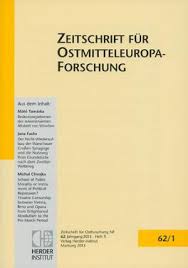Justiz und Propaganda. „Polengreuel“-Prozesse in den eingegliederten Ostgebieten in Presse und Publizistik 1939-1945
Justice and Propaganda. “Polish atrocities” Trials in the Annexed Eastern Territories in the Press and Journalism 1939-1945
Author(s): Maximilian BeckerSubject(s): Law, Constitution, Jurisprudence, Communication studies, Political history, Government/Political systems, Politics and communication, WW II and following years (1940 - 1949)
Published by: Verlag Herder-Institut
Keywords: Justice; Propaganda; “Polish atrocities”; Trials; Annexed Eastern Territories; Press; Journalism; 1939-1945;
Summary/Abstract: During the Polish-German war in September 1939 about 4000-5000 Volksdeutsche were killed by Poles in anti-German riots. These events, which in some cases were a reaction to engagements between Polish troops and German subversives, suited German propaganda well: Newspaper articles about the incidents accused the Poles and their government of atrocities against the German minority and claimed that the killings aimed at the extinction of the whole German population in Poland. Therefore the numbers of victims was declared to amount to 58 000 in February 1940. The “September crimes” were used to intensify the negative image of the Poles. Newspaper articles about the alleged Polish atrocities were designed to justify the German occupation and the German reprisals against the Polish civilian population. In the context of propaganda, court trials played a central role. German special courts were set up in the occupied territories right after the Wehrmacht had invaded Poland. Their most important duty in 1939-40 was to penalize the alleged murder of Volksdeutsche by Poles. Because court proceedings followed a formal “legal corset”, they were assigned a high degree of credibility and were seen as objective. It was their purpose to prove the incidents and to punish the perpetrators. Moreover, the courts were asked to verify that the “mass murder” of Volksdeutsche was ordered by the Polish government and military and that “the whole Polish people were guilty” of this. With these conclusions the courts confirmed the propaganda tale. Therefore, especially in the annexed Polish territories, but also in the Reich, newspapers reported constantly about the trials. The account of the Polish crimes took up most of the space in these articles, but they also told the reader that the proceedings were held according to the law and thus emphasized the supposed objectivity of the trials. The public of the proceedings and their depiction in the newspapers enabled the courts to fulfil their core task: to legitimate the occupation and the anti-Polish measures.
Journal: Zeitschrift für Ostmitteleuropa-Forschung
- Issue Year: 64/2015
- Issue No: 1
- Page Range: 1-39
- Page Count: 39
- Language: German

